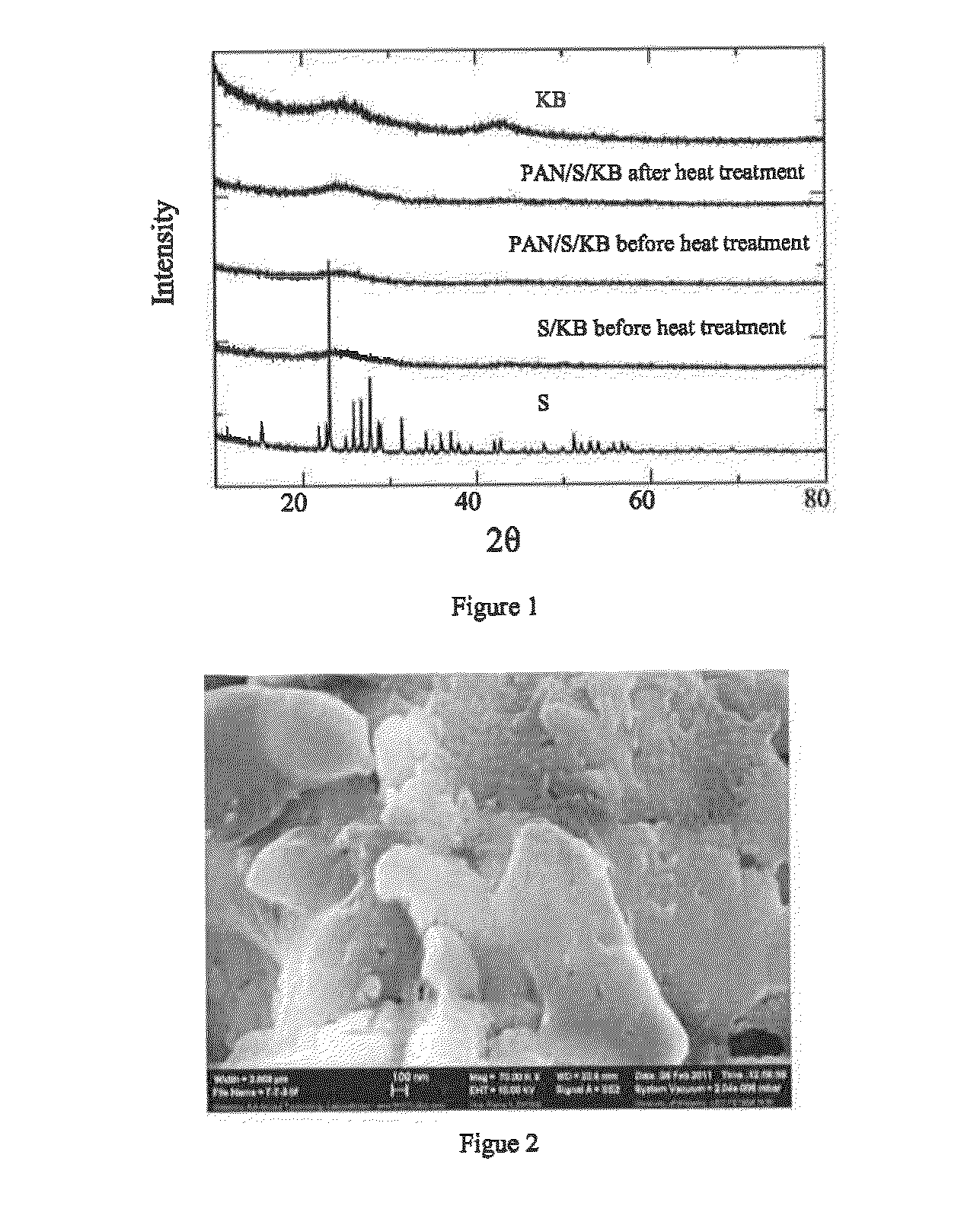Electrode Composite Material, Preparation Method Thereof, Cathode And Battery Including The Same
a composite material and electrode technology, applied in the field can solve the problems of reducing the capacity and safety of batteries, reducing the reversible capacity, and poor conductivity, and achieves the effects of improving the use of electrode composite materials, high performance, and simplifying the method process
- Summary
- Abstract
- Description
- Claims
- Application Information
AI Technical Summary
Benefits of technology
Problems solved by technology
Method used
Image
Examples
example 1
[0202]4 g S is dissolved in 30 cm3 of CS2, then is mixed with the PAN solution in dimethyl formamide(DMF) and dried in a vacuum oven at 65° C. for 3 h to remove the solvents and then heat treated at 350° C. for 3 h in a tubular furnace in Ar gas to make sulfur melt and react with PAN, then cooled to prepare the binary S / PAN composite. During the preparation process, the weight ratio of composite precursors (before heat treatment) is S:PAN=4:1.
[0203]FIG. 1 shows the XRD spectra of sulfur, KB and the composite PAN / S / KB prepared via mechanical and solution routes. It can be seen that the characteristic peaks of sulfur disappear in the composite S / KB and PAN / S / KB, and sublimed sulfur precipitates in highly crystallized form when cooled to the ambient temperature, which can be an indication of that element sulfur in melting state can be trapped into the carbon based grid and pores of PAN, and partially participate in bonding reaction to form sulfur based composite. The samples are weight...
example 2
[0205]4 g S is dissolved in 30 cm3 of CS2, then is mixed with the PAN solution in DMF by ball milling at 800 rpm for 2 h with Mg0.6Ni0.4O, and dried in a vacuum oven at 65° C. for 3 h to remove the solvents and then heat treated at 350° C. for 3 h in a tubular furnace in Ar gas, then cooled to prepare the ternary composite PAN / S / Mg0.6Ni0.4O. During the preparation process, the weight ratio of composite precursors (before heat treatment) is S:PAN:Mg0.6Ni0.4O=4:1:0.3.
[0206]FIG. 3 shows the SEM image of the prepared ternary composite PAN / S / Mg0.6Ni0.4O. One can see that the surface morphology of the binary composite PAN / S is quite different from that of the ternary composite PAN / S / Mg0.6Ni0.4O. The ternary composite PAN / S / Mg0.6Ni0.4O surface is rough and consists of many agglomerated nanosized particles, which could enhance the materials reactivity via increasing the available reactive surface area of the composite. Also, this morphology change could be due to the formation of the surfac...
example 3
[0207]4 g S is dissolved in 30 cm3 of CS2 with KB, and dried in a vacuum oven to remove the solvent CS2, then mixture of S / KB is obtained. PAN is dissolved in DMF, then is mixed with the mixture of S / KB by ball milling at 800 rpm for 2 h with Mg0.6Ni0.4O, and dried in a vacuum oven at 65° C. for 3 h to remove the solvents and then heat treated at 350° C. for 3 h in a tubular furnace in Ar gas, then cooled to prepare the quaternary composite PAN / S / KB / Mg0.6Ni0.4O. During the preparation process, the weight ratio of composite precursors (before heat treatment) is S:PAN:KB:Mg0.6Ni0.4O=4:1:0.25:0.25.
[0208]FIG. 4 presents the SEM images of the quaternary composite PAN / S / KB / Mg0.6Ni0.4O. The addition of KB leads to the electronic conductivity improvement and prevents the agglomeration of the material during ball milling. One can see from FIG. 4 that the addition of KB into the sulfur-polymer composite leads to the reduced agglomeration of the quaternary composite nanoparticles compared with...
PUM
| Property | Measurement | Unit |
|---|---|---|
| temperature | aaaaa | aaaaa |
| temperature | aaaaa | aaaaa |
| diameter distribution | aaaaa | aaaaa |
Abstract
Description
Claims
Application Information
 Login to View More
Login to View More - R&D
- Intellectual Property
- Life Sciences
- Materials
- Tech Scout
- Unparalleled Data Quality
- Higher Quality Content
- 60% Fewer Hallucinations
Browse by: Latest US Patents, China's latest patents, Technical Efficacy Thesaurus, Application Domain, Technology Topic, Popular Technical Reports.
© 2025 PatSnap. All rights reserved.Legal|Privacy policy|Modern Slavery Act Transparency Statement|Sitemap|About US| Contact US: help@patsnap.com



